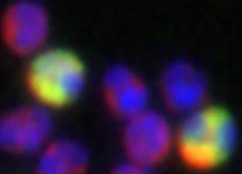Odorant receptors on blood cells
Do we smell with the immune system?

At the 245th National Meeting & Exposition of the American Chemical Society Prof. Peter Schieberle , leader of the Chair of Food Chemistry at the Technische Universität München and Director of the German Research Centre for Food Chemistry(*), explained that scientists thought that the nose had a monopoly on olfactory receptors. The discovery of olfactory receptors on other, non-olfactory cells came as a surprise.
“The team led by Dr. Dietmar Krautwurst recently discovered that blood cells have odorant receptors,” said Schieberle. “In the nose, these so-called receptors sense substances called odorants and translate them into an aroma that we interpret as pleasing or not pleasing in the brain.
But surprisingly, there is growing evidence that also the heart, the lungs and many other non-olfactory organs have these receptors. And once a food is eaten, its components move from the stomach into the bloodstream. But does this mean that, for instance, the heart ‘smells’ the steak you just ate? There is no ultimate answer to that question.”
Immune cells in the blood are able to recognize certain ingredients in food. However, “smelling” is limited to the nose, even though the receptors are the same. In the case of blood cells we talk about “chemoreception”.
Blood cells move toward the odor
Schieberle’s team at DFA recently found that primary blood cells isolated from human blood samples are attracted to the odorant molecules responsible for producing a certain aroma. He described one experiment in which scientists put an attractant odorant compound on one side of a partitioned multi-well chamber, and blood cells on the other side. The blood cells moved toward the odor.
“Once odor components are inside the body, however, it is unclear whether they are functioning in the same way as they do in the nose,” he stated. “But we would like to find out.”
Schieberle’s group and colleagues at Technische Universität München work in a field termed “sensomics,” which focuses on understanding exactly how the mouth and the nose sense key aroma, taste and texture compounds in foods, especially comfort foods like chocolate and roasted coffee.
(*)DFA: Deutsche Forschungsanstalt für Lebensmittelchemie
Publication:
Biogenic amines activate blood leukocytes via trace amine-associated receptors TAAR1 and TAAR2; Agne Babusyte, Matthias Kotthoff, Julia Fiedler, and Dietmar Krautwurst; Journal of Leukocyte Biology, Volume 93, March 2013.
Contact:
Priv.-Doz. Dr. Dietmar Krautwurst
German Research Centre for Food Chemistry
T: +49.8161.71.2634
E: dietmar.krautwurst@lrz.tum.de
W: www.dfal.de
Prof. Dr. Peter Schieberle
Technische Universität München
Chair of Food Chemistry
T: +49.8161.71.2932
E: Peter.Schieberle@lrz.tu-muenchen.de
W: http://www.leb.chemie.tu-muenchen.de/